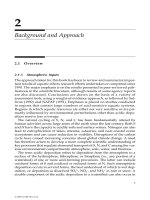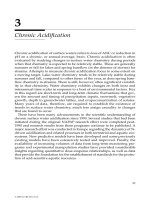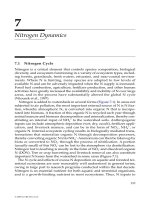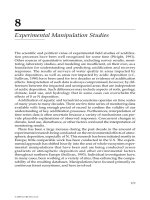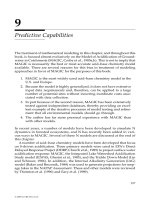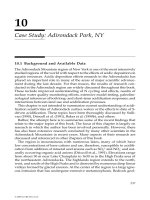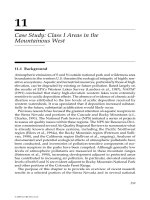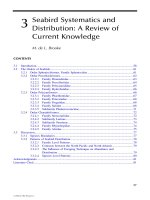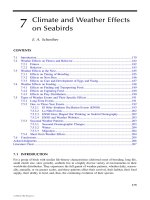ENVIRONMENTAL RESTORATION of METALSCONTAMINATED SOILS - CHAPTER 7 pot
Bạn đang xem bản rút gọn của tài liệu. Xem và tải ngay bản đầy đủ của tài liệu tại đây (2.53 MB, 45 trang )
121
7
Physical Separation of Metal-Contaminated Soils
Clint W. Williford, Jr. and R. Mark Bricka
CONTENTS
7.1 Introduction 122
7.1.1 The Problem of Metals Contamination 122
7.1.2 The Purpose and Scope of This Chapter 122
7.2 Extent and Nature of Contamination 123
7.3 Soil Characteristics and Heavy Metal Contaminants 124
7.3.1 Soil Characteristics 124
7.3.1.1 Definition/Properties of Soils 124
7.3.2 Properties and Behavior of Metals/Inorganics 124
7.3.3 Toxicity 125
7.3.4 Heavy Metal Interactions with Soil Particles 125
7.3.4.1 Parameters Affecting Association with Soil 125
7.3.4.2 Surface Area Effects 125
7.3.4.3 Mechanisms for Accumulation 126
7.3.4.4 Geochemical Substrates 126
7.4 Soil Property Data Required for Investigation and Remediation 126
7.4.1 Physical Properties 126
7.4.2 Site and Soil Characterization 127
7.4.3 Implications for Treatment Methods 128
7.5 Physical Separation 129
7.5.1 Background 129
7.5.2 Fundamentals of Physical Separation 130
7.5.3 Sized-Based Separation 130
7.5.3.1 Screening 130
7.5.3.2 Sample Results for Size Separation of Contaminated Soil and
Sediment 133
7.5.4 Gravity-Based (Density) Separation 134
7.5.4.1 Vertical Column Hydroclassification 134
7.5.4.2 Spiral Classifiers 137
7.5.4.3 Sample Results for Vertical Column Hydroclassification 137
7.5.4.4 Hydrocyclones 143
7.5.4.5 Sample Results for Hydrocyclones Separation of Contaminated
Soil 144
7.5.4.6 Mineral Table 145
7.5.5 Attrition Scrubbing 147
7.5.5.1 Sample Results for Attrition Scrubbing with Wet Tabling 150
7.5.5.2 Sample Results for Attrition Scrubbing with Hydroclassification 151
4131/frame/C07 Page 121 Friday, July 21, 2000 4:53 PM
© 2001 by CRC Press LLC
122
Environmental Restoration of Metals–Contaminated Soils
7.5.6 Flotation 151
7.5.6.1 Sample Results for Application of Flotation to Contaminated Soil .155
7.5.7 Other Technologies 155
7.6 Integrated Process Trains 155
7.6.1 Volume Reduction Unit (VRU) 156
7.6.2 Toronto Harbor Soil Recycle Treatment Train 157
7.6.3 Volume Reduction and Chemical Extraction System (VORCE) 159
7.6.4 Application of Physical Separations Systems 159
7.7 Summary 161
References 163
7.1 Introduction
7.1.1 The Problem of Metals Contamination
Numerous industrial, construction, and military practices have contaminated soil and
water with heavy metals and organics. Examples include use of lead-based paints, firing
ranges, electroplating, and nuclear materials manufacture (Bricka et al., 1993). Heavy met-
als frequently disrupt metabolic processes and produce toxic effects in the lungs, kidneys,
and central nervous system. Organometallic forms such as dimethyl mercury are highly
toxic. Heavy metals contamination threatens both industrial sites and heavily populated
areas. Furthermore, the “indestructible” nature of metals has limited options for remedia-
tion to solidification/stabilization, “dig and haul,” and to a lesser extent soil flushing. The
1993 EPA Status Report on Innovative Treatment Technologies (U.S. EPA, 1993a) states that
of 301 innovative treatment applications (as of June 1993), only 20 involved metals. Reme-
diation costs on the order of $500 per cubic meter, and more for radioactive materials, moti-
vate research to minimize volumes requiring costly treatment and to improve the efficiency
of those treatments.
The physical separation approach reviewed here uses minerals processing technologies
to deplete soil fractions of contaminants. The depleted soil should require less aggressive
follow-up treatment, and cost effectiveness should be improved for solidification or soil
flushing. Research is needed to assess, select, and integrate separations technologies for
partitioning contaminants among soil fractions.
7.1.2 The Purpose and Scope of This Chapter
Here we review and provide guidance for the adaptation of minerals processing technolo-
gies for the separative remediation of heavy metal contaminated soils. An enriched fraction
is obtained for intense treatment, as well as a depleted fraction, for disposal of onsite or sim-
pler treatment. Remediation can be simplified and dollar resources used more effectively.
This review acquaints the reader with (1) the extent and nature of metal contamination
in soil; (2) soil characterization needs; (3) principles, unit operations, and experimental
results for remediation technologies based on physical separation; and finally (4) descrip-
tions and applications of integrated process trains.
Though not exhaustive, the discussion of recent research and applications covers signifi-
cant and representative methods. Most are adaptations of placer mining techniques in which
moving water (or air) is used to selectively carry smaller-sized, less dense components of the
4131/frame/C07 Page 122 Friday, July 21, 2000 4:53 PM
© 2001 by CRC Press LLC
Physical Separation of Metal-Contaminated Soils
123
soil away from larger-sized, denser components that settle more quickly. Separation meth-
ods reviewed are based on size, density, and surface hydrophobicity. Specific technologies
include screening, mineral tabling, hydroclassification, and flotation. Integrated systems
are discussed incorporating, for example, a barrel trommel, screens, an attrition scrubber,
and hydrocyclones. Discussion is organized in the following sections:
• Extent and Nature of Contamination
• Soil Characteristics and Heavy Metal Contaminants
• Soil Property Data Required for Investigation and Remediation
• Physical Separation
• Integrated Process Trains
• Summary
7.2 Extent and Nature of Contamination
Here, we briefly describe contamination at military installations as a representative example
of the magnitude and nature of the problem. It is estimated that the Department of Defense
(DOD) has about 1900 installations worldwide, containing about 11,000 individual sites, that
will require some form of active remedial action (Table 7.1). As of 1994, 93 of these were listed
on the EPA’s Superfund National Priorities List (U.S. Department of Defense, 1993).
The end of the Cold War accelerated downsizing and closure of a number of military
facilities. The pressures to convert these properties to civilian purposes has grown more
imperative. Some facilities, e.g., Fort Ord, CA, occupy properties with high economic
value. Of the 165 federal facility sites on the NPL, 35 are also Base Realignment and Closure
Sites (U.S. EPA, 1998a).
Metals-contaminated sites include artillery and small arms impact areas, battery dis-
posal areas, burn pits, chemical disposal areas, contaminated marine sediments, disposal
wells and leach fields, electroplating/metal finishing shops, firefighting training areas,
landfills and burial pits, leaking collection and system sanitary lines, leaking storage tanks,
radioactive and mixed waste disposal areas, oxidation ponds/lagoons, paint stripping and
spray booth areas, blasting areas, surface impoundments, and vehicle maintenance areas
(Bricka et al., 1993; Marino et al., 1997).
Typically, heavy metals contamination occurs in sludges, contaminated soil and debris,
surface water, and groundwater. Sandblasting, lead-based paints, and firing range opera-
tions have produced soils with discrete metal-rich particles. In contrast, electroplating and
cooling tower discharges have produced ionic forms of heavy metal contaminants that
TABLE 7.1
Examples of Types of Physical and Chemical Partitioning
Physical Factors Chemical Interactions Chemical Phase Groups
Grain size Adsorption Interstitial water
Surface area Precipitation or coprecipitation Carbonates clay minerals
Specific gravity Organmetallic bonding Hydrous Fe and Mn oxides
Surface charge Cation exchange Sulfides
Water content Incorporation in minerals lattices Silicates
From Horowitz, A.J.,
A Primer on Sediment-Trace Element Chemistry
, 2nd ed., Lewis Publishers, Chelsea, MI, 1991.
4131/frame/C07 Page 123 Friday, July 21, 2000 4:53 PM
© 2001 by CRC Press LLC
124
Environmental Restoration of Metals–Contaminated Soils
associate with soil particles. A survey conducted by Bricka et al. (1994) indicates the most
frequently cited metal contaminants at military installations are lead, cadmium, and chro-
mium. Mercury and arsenic occur to a lesser extent, but are of concern due to their extreme
toxicity. Of particular concern are abandoned firing ranges. Very high levels of lead
(1000s of ppm) are generally found in the berms and soils surrounding such areas, requir-
ing remediation activities.
7.3 Soil Characteristics and Heavy Metal Contaminants
7.3.1 Soil Characteristics
7.3.1.1 Definition/Properties of Soils
In remediation, we focus on the geochemical/geotechnical properties of soil vs. the agricul-
tural. Soil occurs naturally at or near the surface. It combines mineral matter from the
breakdown of rocks and organic matter from the decomposition of plants and animals. A
liquid phase consists primarily of water with dissolved solids, and a gaseous phase consists
primarily of air with carbon dioxide from plant and animal respiration (Briggs, 1977). Soils
result from three types of processes: autogenic processes (weathering and biological) may
form a soil at a given location; detrital (suspension in air and water) may move soil from
one location to another; and anthropogenic (human) activities may move the soil or modify
it, for example by compaction, tilling, or addition of fertilizer, lime, or aggregate. The fol-
lowing sections on soil characteristics summarize the major parameters describing the soil
and terms for classifying.
Four classes of properties describe soils:
1.
Physical properties
include soil texture, structure, aggregate stability (consistency),
density, and porosity.
2.
Hydrological properties
include the classification of soil water, capacity, chemical
content, and interaction with oxidation/reduction reactions and soil structure
(clay moisture regime).
3.
Chemical properties
include pH, buffering capacity, cation exchange capacity,
organic content, and surface substrates.
4.
Biological properties
include the nature of the flora (e.g., bacterial, fungal, and
actionomycetes) and fauna (e.g., earthworms, protozoa) communities and how
they interact with organic matter decomposition and nutrient cycling (U.S.
Department of Agriculture, Soil Conservation Service, 1988; Briggs, 1977).
7.3.2 Properties and Behavior of Metals/Inorganics
Selection of remediation technologies may be immediately narrowed, based on the presence
and form of one or more contaminants, e.g., discrete metal fragments or adsorbed species
(U.S. EPA, 1998b). Likewise, relative amounts of each may tend to favor certain technologies.
Metals may be found sometimes in the elemental form, but more often they are found as salts
mixed in the soil. Metals, unlike organic contaminants, cannot be destroyed (or mineralized)
through treatment technologies such as bioremediation or incineration. Once a metal has con-
taminated a soil, it will remain a threat to the environment until it is removed or rendered
4131/frame/C07 Page 124 Friday, July 21, 2000 4:53 PM
© 2001 by CRC Press LLC
Physical Separation of Metal-Contaminated Soils
125
immobile. The fate of the metal depends on its physical and chemical properties, the associ-
ated waste matrix, and the soil. Significant transport of metals from the soil surface occurs
when the metal retention capacity of the soil is exceeded or when metals are solubilized
(e.g., by low pH). As the concentration of metals exceeds the ability of the soil to retain them,
the metals may travel downward with leaching waters. Surface transport through dust and
erosion of soils is also a common transport mechanism. The extent of vertical contaminant
distribution intimately relates to the soil solution and surface chemistry. Currently, treatment
options for radioactive materials are generally limited to volume reduction/concentration
and immobilization. Properties and behavior of specific inorganics (e.g., chromium, lead,
mercury, etc.) and inorganic contaminant groups are readily available online and are summa-
rized in the Remediation Technologies Screening Matrix and Reference Guide Version 2.0
(U.S. EPA, 1998b).
7.3.3 Toxicity
The toxicities of metals are presented at length elsewhere in this text. Major toxic effects of
a number of compounds referred to as heavy metals are also described in Amdur et al.
(1991) and Manahan (1990).
7.3.4 Heavy Metal Interactions with Soil Particles
7.3.4.1 Parameters Affecting Association with Soil
The primary parameters affecting the association of a heavy metal with soil and sediment
include grain size and surface area, the nature of the geochemical substrate, metal species,
and affinity of the metal for the soil. Most organic and inorganic contaminants tend to bind
chemically or physically to clay and silt particles. These are attached to sand and gravel by
physical processes, primarily compaction and adhesion. Table 7.1 presents factors and
characteristics of physical and chemical partitioning of metals between soil and surround-
ing media (Horowitz, 1991).
Physical factors subdivide sediments or soils according to their physical properties:
grain-size distribution, surface area, surface charge, density, or specific gravity. Chemical
phase groups describe the different geochemical substrates that form the basis of the soil,
such as carbonates, clay minerals, organic matter, iron and manganese oxides, and hydrox-
ides, sulfides, or silicates. Chemical interactions characterize the different types of associa-
tion between metals and the geochemical substrates. The most important interactions are
adsorption, precipitation, organometallic bonding, and incorporation into crystal lattices
(Horowitz, 1991).
7.3.4.2 Surface Area Effects
Heavy metals, in ionic form, predominantly associate with smaller, higher surface area par-
ticles. Clay-sized sediments (<2 to 4
µ
m) have surface areas of tens of square meters per
gram. Sand-sized particles have surface areas of tens of square centimeters per gram (Grim,
1968; Jones and Bowser, 1978). A very strong correlation exists between decreasing grain
size and the amount of heavy metal held by the soil fraction.
Horowitz (1991) reported the concentration of copper in a marine sediment having its
highest value for the smallest clay particles. The <2-
µ
m fraction had a concentration of
750 mg/kg, about seven times higher than for any other fraction. While it comprised
20 wt% it held about 75% of the copper. Such selective concentration of metals supports the
application of physical separations. These observations also support a need to determine
4131/frame/C07 Page 125 Friday, July 21, 2000 4:53 PM
© 2001 by CRC Press LLC
126
Environmental Restoration of Metals–Contaminated Soils
metal distribution of particle size as well as physical and chemical state. For example, the
lead in firing range soil would consist of particles and smears, while a sample from a bat-
tery reworking operation would have adsorbed and ion-exchanged lead species. The form
of the contaminant and its association with the soil would be very different. These differ-
ences would strongly impact the choice of a treatment process.
7.3.4.3 Mechanisms for Accumulation
Adsorption can take place by physical adsorption, chemical adsorption, and ion exchange
(Lieser, 1975). Physical adsorption on a particle surface results from van der Waals forces
or relatively weak ion-dipole or dipole-dipole interactions and is reversible. These occur
with iron oxides, aluminum oxides, clay minerals, and molecular sieves, such as zeolites
(Calmano and Forstner, 1983).
The solid phase also has a certain exchange capacity (CEC) for holding and exchanging
cations. In soil components this effect is primarily due to the adsorptive properties of neg-
atively charged anionic sites such as Si(OH)
2
and AI(OH) (clay minerals), FeOH (iron
hydroxides), and COOH and OH (organic matter) (Forstner and Wittman, 1981; Horowitz,
1991). The type of adsorption is affected by the composition of the geochemical substrate,
and thus its composition.
7.3.4.4 Geochemical Substrates
The geochemical substrates that are most important in collecting and retaining heavy met-
als occur in abundance and have large surface areas, ion exchange capacities, and surface
charges. They also tend to predominately occur in the smaller size fraction material. These
substrates include iron and manganese oxides, organic matter, and clay minerals.
Iron and manganese oxides are well-known scavengers of heavy metals (Goldberg, 1954;
Krauskopf, 1956). Surface areas are on the order of 200 to 300 m/g (Fripiat and Gastuche,
1952; Buser and Graf, 1955).
Organic matter in soils and suspended and bottom sediments have a large capacity to
concentrate heavy metals (Goldberg, 1954; Krauskopf, 1956; Horowitz and Elrick, 1987; and
Hirner et al., 1990). Organic surface coatings tend to concentrate in the smaller size frac-
tions, while discrete particles tend to concentrate in the ore coarse size fraction (Horowitz
and Elrick, 1987).
The main role of clays in metals collection may not, however, stem directly from its surface
properties, but from its high surface area, supporting other substrates (Horowitz, 1991).
7.4 Soil Property Data Required for Investigation and Remediation
The vertical and horizontal contaminant profiles clearly define the overall range and diver-
sity of contamination across the site. Obtaining this information generally requires taking
sampling and analysis of physical and chemical characteristics. This conveys the specific
data needs (for remediation) that can be met during the initial stages of the investigation.
7.4.1 Physical Properties
Physical properties of soil significantly affecting the application of physical separation
include the following (U.S. EPA, 1993b; 1994):
4131/frame/C07 Page 126 Friday, July 21, 2000 4:53 PM
© 2001 by CRC Press LLC
Physical Separation of Metal-Contaminated Soils
127
• Soil particle size distribution
• Clay content
• Heterogeneity
• Geochemical makeup (organic content, humic content, other organics)
Site soil conditions frequently limit the selection of a treatment process. Process-limiting
characteristics such as pH or moisture content may sometimes be adjusted. In other cases,
a treatment technology may be eliminated based upon the soil classification (e.g., particle-
size distribution) or other soil characteristics.
Usually, properties vary much more vertically than horizontally. This results from the
variability in the processes that originally formed the soils. Soil variability results in vari-
ability in the distribution of water and contaminants and their transport within, and
removal from, the soil at a given site.
Soil particle-size distribution may be the key factor in many soil treatment technologies.
In general, coarse, unconsolidated materials, such as sands and fine gravels, are easiest to
treat. Soil washing may be ineffective where high percentages of silt and clay inhibit sepa-
ration of the adsorbed contaminants from fine particles and wash fluids.
The bulk density of soil is the weight of the soil per unit volume, including water and
voids. It is used in converting weight to volume in materials-handling calculations and esti-
mating whether proper mixing and heat transfer will occur.
Particle density is the specific gravity of a soil particle. Differences in particle density are
important in heavy mineral/metal separation processes (heavy media separation). Particle
density is also important in soil washing and in determining the settling velocity of sus-
pended soil particles in flocculation and sedimentation processes.
Other important parameters include clay content, organics (humic materials), and iron.
Clay content affects soil processing in several respects. High clay content will lead to low
permeabilities, inhibiting any
in situ
procedure. Clay increases the plasticity of the soil lead-
ing to clumping and mechanical handling problems. The large surface area of the particles
contributes to contaminant adsorption. Finally, fine clay particles will remain suspended in
process water, thus requiring dewatering techniques. These can represent a significant por-
tion of the hardware requirement.
Humic content (organic fraction) is the decomposing part of the naturally occurring
organic content of the soil. High humic content will act to bind metals to the soil, decreasing
their mobility and the threat to groundwater; however, high humic content can inhibit soil
vapor extraction (SVE), steam extraction, soil washing, and soil flushing as a result of
strong adsorption of the contaminant by the organic material. Mercury is strongly sorbed
to humic materials. Inorganic mercury sorbed to soils is not readily desorbed; therefore,
freshwater and marine sediments are important repositories for inorganic mercury.
Clay carbonates, or hydrous oxides, readily adsorb zinc (Zn). The greatest percentage of
total zinc in polluted soil and sediment is associated with iron (Fe) and manganese (Mn)
oxides. Rainfall removes zinc from soil because the zinc compounds are highly soluble.
Table 7.2 summarizes physical and chemical soil characteristics required for planning
treatability studies (U.S. EPA, 1990).
7.4.2 Site and Soil Characterization
The successful implementation of a physical separation remediation requires a thorough
characterization protocol of the site, soil, and contaminant. Hansen (1991) compared the
steps in planning mineral extraction to those for remediation and provided the following
outline (Figure 7.1).
4131/frame/C07 Page 127 Friday, July 21, 2000 4:53 PM
© 2001 by CRC Press LLC
128
Environmental Restoration of Metals–Contaminated Soils
The U.S. EPA (1991) developed a two-tier protocol, focusing on soil (waste) characteriza-
tion for radioactively contaminated soils. Tier 1 analysis includes finding the concentration
of the contaminant; size classification to determine the mass and contaminant distributions
according to size; and petrographic analysis to identify the mineral species and determine
shape, hardness, weathering, coatings, and aggregation. A density separation is made on
sand and silt size fractions. Tier II tests focus on coatings or materials requiring more pre-
cise instrumentation. Tests are performed to assess particle separation, particle liberation
(physical debonding), and chemical extraction. This provides the basis to assess applicabil-
ity of specific treatment technologies. Specific treatability procedures appear in “Superfund
Treatability Study Protocol: Bench Scale Level of Soils Washing For Contaminated Soil”
(U.S. EPA, 1989a).
7.4.3 Implications for Treatment Methods
The strong tendency of metals to associate with distinct soil/sediment fractions offers
opportunities to selectively separate heavy metal from contaminated soil. For example,
more than 90 mass percent of lead in a firing range soil may occur in the >2.0-mm fractions.
Chemical, physical, and biological methods can immobilize the metals, separate them from
the particle, or separate and concentrate the most contaminated particles. The enrichment of
adsorbed contaminants, generally in the finer size fractions, means this fraction will probably
require follow-up treatment. In addition to separating solid particles, contaminants may be
mobilized into solution, requiring water treatment with precipitation or ion exchange.
Physical separation can be used standing alone or with other treatment processes. It may
achieve acceptable levels alone, but in other cases is most effective combined with other
TABLE 7.2
Waste Soil Characterization Paramenters
Parameter Purpose and Comment
Key physical Particle size distribution
>2 mm
0.25–2 mm
0.063–0.25 mm
<0.063 mm
Oversize pretreatment requirements
Effective soil washing
Limited soil washing
Clay and silt fraction — difficult soil washing
Other
physical
Type, physical form, handling properties
Moisture content
Affects pretreatment and transfer requirements
Affects pretreatments and transfer requirements
Key chemical Organics
Concentration
Volatility
Partition coefficient
Determine contaminants and assess separation
and washing efficiency, hydrophobic
interaction, washing fluid compatibility,
changes in washing fluid with changes in
contaminants; may require preblending for
consistent feed; use the jar protocol to
determine contaminant partitioning
Metals Concentration and species of constituents
(specific jar test) will determine washing fluid
compatibility, mobility of metals, posttreatment
Humic acid Organic content will affect adsorption
characteristics of contaminants on soil
important in marine/wetlands sites
Other
chemical
pH, buffering capacity May affect pretreatment requirements,
compatibility with equipment materials of
construction, wash fluid compatibility
From U.S. EPA, Soil Washing Treatment, Eng. Bull., Office of Emergency and Remedial Response, EPA/540/2-90/
017, 1990.
4131/frame/C07 Page 128 Friday, July 21, 2000 4:53 PM
© 2001 by CRC Press LLC
Physical Separation of Metal-Contaminated Soils
129
treatment processes. It may reduce volume or may convert soil to a more homogeneous
condition improving further processing. It is most effective with sandy soil; performance
declines with increasing clay and silt content, especially as a stand-alone technology. Soils
with high percentages of silt and clay tend to strongly adsorb contaminants.
Soil washing alone is not advised. Hydrophobic contaminants generally require surfac-
tants or organic solvents for their removal. Complex contaminant mixes including metals
and nonvolatile organics and semivolatile organics and frequent changes in composition
make selection/formulation of washing fluids difficult. Surfactants and chelators may
improve contaminant removal efficiencies, but may also interfere with downstream water
treatment (U.S. EPA, 1989a; 1989b).
Finally, the use of soil slurries generates significant volumes of water with suspended sol-
ids. Removal and concentration of the suspended soils can require a third (on a size basis)
of the unit operations brought to a site. Use of “dry” pneumatic systems eliminates this
problem. These systems generally separate more slowly and less efficiently, relative to
water slurry systems (Silva, 1986). However, they have been successfully employed, for
example to remediate firing range soil at a police firing range in New York City (MARCOR
Remediation, Inc., 1997).
7.5 Physical Separation
7.5.1 Background
In 1993, the U.S. Army Corps of Engineers (USACE) Waterways Experiment Station (WES)
Environmental Laboratory (EL) reviewed technologies for treatment of metals-contami-
nated soil that warranted further development and implementation (Bricka et al., 1993). The
project report concluded that few advanced technologies were widely practiced for heavy
metals-contaminated soil. Questions existed for many technologies (major concerns were
FIGURE 7.1
Flowchart for environmental site remediation
process development.
4131/frame/C07 Page 129 Friday, July 21, 2000 4:53 PM
© 2001 by CRC Press LLC
130
Environmental Restoration of Metals–Contaminated Soils
production of residual streams and long-term stability of treated metals left in the soil). It
was also concluded that additional research was needed to resolve concerns and better
understand fundamentals of some processes.
A second WES report (Bricka et al., 1994) integrated the first report, a survey of contami-
nation at installations, and a final analysis by WES-EL, Restoration Branch staff. This report
prioritized technologies and identified research needs to field one or more technologies in
5 years. It concluded that (1) extraction methods coupled with physical separation offered
the most promising and appropriate area for continued research; and (2) a limited number
of precipitation and thermal processes (roasting and enhanced volatilization) warranted
further research support.
These reports and Web-based material by U.S. EPA (1998d) provide a wide-ranging
review of technologies (presumptive and innovative), including descriptions, modes of
action, applications, and limitations. Based on reviews such as these, and a growing aware-
ness in the late 1980s to early 1990s of the need for metals-remediation alternatives, a num-
ber of organizations began to explore and develop systems for physical separations.
7.5.2 Fundamentals of Physical Separation
Heavy metals can exist as discrete particles, adsorbed species, or dissolved species. Lead
paint deterioration, sand blasting, and firing range operations produce discrete fragments
of metallics smear on soil particles. Electroplating, battery reworking, and cooling tower
discharge can produce ionic metals associated with soil particles.
Each form of metal contamination exhibits different physical properties: particle size,
density, and surface charge depending upon the metallic particles, soil characteristics, and
contaminant. To the extent that these particles differ from those of the soil, the contamina-
tion will not occur uniformly in the soil, but will associate disproportionately with partic-
ular soil fractions, e.g., fines. The major parameters affecting the association of a heavy
metal with soil and sediment include grain size, surface area, geochemical substrate, and
metal affinity (Horowitz, 1991).
The general approach in physical separations remediation is to use unit operations com-
monly applied in the minerals processing industry. Most exploit differences in particle size,
density, and surface properties to effect a separation. Other methods exploit magnetic and
electrostatic properties. Ideally, the “cleaned” fraction will require no further treatment,
and the “concentrated” fraction can be more economically processed. A conceptual process
train (U.S. Bureau of Mines, 1991) appears in Figure 7.2. The following material presents
the principles of operation of a number of major unit operations, along with experimental
results that inform us of their performance and limitations. Examples are given of how
these individual unit operations have been integrated into process trains. The flowsheet in
Figure 7.2 will be described in further detail at that point. Table 7.3 shows categories of tech-
nologies subdivided according to the principle of separation, e.g., size or density. Signifi-
cant technologies and applications are listed.
7.5.3 Size-Based Separation
7.5.3.1 Screening
Screening uses size exclusion through a physical barrier. Although simple in concept,
screening has often been described as more art than science. A wide range of screens exists,
both stationary and vibrating, and each screen has a specific purpose and application.
4131/frame/C07 Page 130 Friday, July 21, 2000 4:53 PM
© 2001 by CRC Press LLC
Physical Separation of Metal-Contaminated Soils
131
Once the possibility of a separation has been established, estimation of screen perfor-
mance requires estimation of screen efficiency and screen capacity. In environmental reme-
diation, the goal may often be to recover oversized material while smaller, more highly
contaminated fractions pass through the screen. In such cases the screen efficiency can be
calculated as the ratio of oversized recovery to the oversize feed.
Screen capacity may be estimated on a unit area basis as the ratio of flow-through capac-
ity (tons) to overall unit capacity (tons/h-ft
2
), modified by some correction factor. Correc-
tion factor derivations vary widely on the basis of the nature of the material to be screened,
the application, screen opening size, and technical reference. The empirical nature of
screening technology requires laboratory and pilot analysis and field experience in the ini-
tial phase of screen selection to estimate performance beyond preliminary design.
Accordingly, bench-scale screening (sieving) assesses the mass and contaminant distribu-
tion among the soil size fractions. This is one of the key assessments in treatability studies
for evaluating the feasibility of physical separation and the choice of separation unit oper-
ations. Figures 7.3 and 7.4 show the equipment and procedures for wet sieving of a metal-
contaminated soil. With some modification, these procedures involve a vigorous agitation
with a water/soil ratio of 4:5 five (Figure 7.3), followed by wet-sieving (Figure 7.4), with
screen openings of 10 mm down to 63
µ
m, and with several intermediate sizes, 100
µ
m.
FIGURE 7.2
Conceptual process train for remediation of lead-contaminated firing range soil. (From U.S. Bureau of Mines,
Heavy Metal Removed from Small Arms Firing Ranges, R. McDonald, Ed., prepared for U.S. Naval Civil
Engineering Research Laboratory, Salt Lake City Research Center, Salt Lake City, UT, 1991.)
ORE
SCREEN
HEAP LEACH
BULLETS
HEAP LEACH
CYCLONE
TABLE
HEAP LEACH
DRY
JIP
AIR CLASSIER
BAG HOUSE
PELLETIZER
SPIRALS
FRAGMENTS
4131/frame/C07 Page 131 Friday, July 21, 2000 4:53 PM
© 2001 by CRC Press LLC
132
Environmental Restoration of Metals–Contaminated Soils
During wet sieving, the soil on the screen is washed with and agitated in water to facilitate
the separation and passage of smaller particles through the screen openings.
Commercial-scale stationary screen designs range from grizzlies, used to scalp cobbles
and debris, to wedge-bar screens and hydro sieves used for size separation down to
10 mesh (Weiss, 1985). Moving screens or vibrating screens are most commonly used and
can be arranged in series for progressively finer screening. Vibrating screens are most com-
monly used to separate material ranging from 1/8 in. to 6 in., with high speed vibrating
screens available for separation of material ranging from 4 to 325 mesh (Averett et al., 1990).
Beyond size separation, screens are also used for dewatering, scalping, media recovery, and
the removal of very fine particles in wet or dry media, known as desliming or dedusting,
respectively. The following photographs in Figures 7.5 and 7.6 show a commercial screen
system with a close-up of the screen deck. Figure 7.7 shows a grizzly with a hopper on top
and a conveyor belt exiting on the lower left. A close-up of the bars across the top of the
hopper appears in Figure 7.8. The entrance to a barrel trommel appears in Figure 7.9, show-
ing the water spray and internal baffles that break up and mix the soil. Figure 7.10 shows
the overall view of a small pilot-scale system. Undersize material falls through the screen
around the drum and then into a chute for further processing. The oversize material then
continues to the lip of the drum and then into another chute at a right angle to the drum.
TABLE 7.3
Unit Operations for Physical Separation
Basis of Separation Technology Application
Size Screens
Bench-scale sieves (1,2)
Lead slugs from firing range (2, 4, 5)
Radioactive sand (1, 3)
Density Stokes law settling
hydroclassification (1, 2)
Hindered settling
Mineral table (3)
Mineral jig (3)
Hydrocyclone (1)
Spiral concentrator
Lead slugs from firing range (2, 4, 5)
Radioactive sand (1, 3)
Hydrophilic/hydrophobic Flotation (3, 6, 8) Metal sulfide-contaminated tailings
Magnetic HGMS Iron oxide removal from clay
Disaggreation/declumping Trommel (1)
Attrition scrubber (1, 2, 7)
Preliminary separation to remove debris and
break up soil clumps; remove smaller
(e.g., radioactive) particles from larger ones
Sources:
1. Williford, C.W., Trip report (and photographs) of Volume Reduction and Chemical Extraction System
(VORCE), National Air and Radiation Environmental Laboratory, Montgomery, AL, prepared for U.S. Army
Corps of Engineers (WES-EE-R: R.M. Bricka), Vicksburg, MS, 1991a.
2. Williford, C.W., Jr., Z. Li, Z. Wang, and R.M. Bricka, Vertical column hydroclassification of metal-contaminated
soils,
J. Hazardous Mater.
, 66, 1, 1999.
3. Williford, C.W., Trip report (and photographs) of AWC Lockheed TRUClean process, prepared for Restoration
Branch, U.S. Army Corps of Engineers (WES-EE-R: R.M. Bricka), Vicksburg, MS, 1991b.
4. U.S. Bureau of Mines, Heavy Metal Removed from Small Arms Firing Ranges, R. McDonald, Ed., prepared
for U.S. Naval Civil Engineering Research Laboratory, Salt Lake City Research Center, Salt Lake City, UT, 1991.
5.
U.S. Navy Civil Engineering Laboratory and U.S. Bureau of Mines, Heavy Metal Removal from
Small Arms Ranges: A Pilot-Scale Demonstration at Marine Corps Base, Camp Pendleton, CA, 1993.
6.
U.S. EPA, Toronto Harbor Commissioners (THC) Soil Recycle Treatment-Technology Demonstra-
tion Summary, EPA/540/SR-93/517, 1993c.
7. Marino, M.A., R.M. Bricka, and C.N. Neale, Heavy metal soil remediation: the effects of attrition scrubbing
on a wet gravity process,
Environ. Progress
, 16(3), 208, 1997.
8.
Mann, M. and J. Besch, Divide and conquer,
Soils
, March, 20, 1992.
4131/frame/C07 Page 132 Friday, July 21, 2000 4:53 PM
© 2001 by CRC Press LLC
Physical Separation of Metal-Contaminated Soils
133
These systems, and a mineral jig, have been combined by AWC Lockheed for remediation
of radioactivity-contaminated soils (Williford, 1991b).
Screening serves as a key preliminary unit operation, dividing the soil stream into appro-
priate size fractions for subsequent mineral processing unit operations, e.g., hydrocyclones
or mineral jigs. The quantity, size, and density distribution must be known to size and plan
the layout of these unit operations. Figure 7.11 lists separations unit operations and their
applicable particle size ranges (Mular and Bhappu, 1980). Figure 7.12 shows the applicable
size ranges for soil washing, with respect to physical separation (U.S. EPA, 1990). For soils
in Regime I, these coarse soils are very amendable to soil washing; most contaminated soils
have a size distribution that falls within Regime II (the types of contaminants will govern
the composition of the washing fluid and the overall efficiency of the washing process). In
Regime III, the soils consist of finer sand, silt and clay fractions, and those with highly humic
content. These materials strongly adsorb organics and inorganics and generally do not
respond well to systems attempting to dissolve or suspend the contaminants. They may
respond to soil washing that separates the contaminant-rich fraction into a smaller volume.
7.5.3.2 Sample Results for Size Separation of Contaminated Soil and Sediment
Results of a representative soil/contaminant characterization appear in Figures 7.13 and
7.14. These show the overall mass and lead distribution produced by sieving and hydro-
classification of a firing range soil. On a mass basis (Figure 7.13), this soil appears fine, with
over 40% in the silt and clay range (<63
µ
m). On a lead basis (Figure 7.14), there is a bimodal
distribution of the lead to the larger and smaller size extremes. For the whole soil, the lead
distribution is even more dramatic, with 90+% of the lead slugs and fragments screened out
FIGURE 7.3
Soil and water slurry shaken before separation.
4131/frame/C07 Page 133 Friday, July 21, 2000 4:53 PM
© 2001 by CRC Press LLC
134
Environmental Restoration of Metals–Contaminated Soils
before the assessment of the “soil” fraction smaller than 10 mm in size. The differing results
between sieving and hydroclassification are presented in the following section.
Notice that almost 50% of the mass of the soil (for the size range separated) lies in the
intermediate size fractions. However, the lead distribution is only 2 to 9% in these fractions,
revealing substantial depletion of lead in these fractions.
In other work, sediment from the Great Lakes region was separated by the variety of physical
separation methods (Allen, 1993). Wet sieving enriched a sample identified as “Saginaw #2”
with distribution of 48 to 60% of the chromium, cadmium, and lead to the -400 mesh size
fraction, which comprised just 12.4% of the mass of the feed.
7.5.4 Gravity-Based (Density) Separation
7.5.4.1 Vertical Column Hydroclassification
Many physical separation process trains use gravity-based unit operations such as spiral
hydroclassifiers, hydrocyclones, and mineral tables. These systems operate on the principle
that the settling behavior is a function of size and density. A simple treatability test, hydro-
classification, proves useful to assess the application of such unit operations. Hydroclassi-
fication determines free settling characteristics governed by Stokes’ law, as opposed to
“hindered settling.” In the latter case, a slurry of water and particles forms a dense media
in which separation occurs. In this section, we describe the general principles of operation
for bench-scale hydroclassification. Of course, industrial-scale operations will use larger
appropriate unit operations. Accordingly, we also describe the equipment and principles of
operation for spiral hydroclassifiers, hydrocyclones, and mineral tables.
FIGURE 7.4
Wet sieving of metals-contaminated
soil through an 8-in. sieve.
4131/frame/C07 Page 134 Friday, July 21, 2000 4:53 PM
© 2001 by CRC Press LLC
Physical Separation of Metal-Contaminated Soils
135
Vertical column hydroclassification uses upward flowing water in a small column to
elute a series of contaminated soil fractions, producing depletion and enrichment of metals
among the fractions. Results provide a best case separation for gravity-based methods, for
example, minerals table, hydrocyclone, mineral jig, spiral concentrator, or hydroclassifier.
FIGURE 7.5
Two deck screen with cast grizzly bar top deck and rod deck on the bottom.
FIGURE 7.6
Close-up of screen (rod) deck.
4131/frame/C07 Page 135 Wednesday, August 9, 2000 3:09 PM
© 2001 by CRC Press LLC
136
Environmental Restoration of Metals–Contaminated Soils
According to Stokes’ law, at low Reynolds number, particles of uniform shape and den-
sity settle through water at rate proportional to their density and the square of their diam-
eter. Stokes’ law for spherical particles falling slowly through water appears in the
following equation (McCabe, et al., 1993):
Figure 7.15 illustrates the forces acting on a settling particle. These include buoyancy, drag,
and gravity. The particle depicted in the center is in balance (equilibrium), with the actual
fluid velocity matching the potential terminal velocity. If the net force is nonzero, the par-
ticle will accelerate until increasing drag force balances the other forces and the particle
reaches its terminal velocity,
u
t
. Relative to the particle in balance, a more dense particle
sinks and a smaller particle rises. This explanation, while essentially correct, does not
account for higher terminal velocities and irregular shapes, which generate Reynolds num-
bers and settling behavior beyond Stokes’ law. Correlations have been adapted using drag
coefficients to correct for these effects. Likewise, experimental data have been collected to
provide empirical relationships. Figure 7.16 shows terminal velocities in water for various
minerals (McCarter, 1982).
As the upward flow of water exceeds the terminal velocity of select particles, they will be
swept out the top of the column to a collection tank. Smaller or less dense particles will be
preferentially removed. Larger, more dense particles will remain in the column until the
flow rate is adjusted upward. Contaminant particles having a size or density distribution
different from that of the host soil will distribute differently than the mass for the soil. This
leads to enrichment and depletion of the contaminant in the resulting particle size fractions.
FIGURE 7.7
Grizzly with hopper and conveyor belt (lower left).
u
t
gD
p
2
ρ
ρ
ρ
ρ–()
18µ
=
4131/frame/C07 Page 136 Wednesday, August 9, 2000 3:09 PM
© 2001 by CRC Press LLC
Physical Separation of Metal-Contaminated Soils
137
The greater the enrichment/depletion, the easier the separation of a contaminant from the
soil using gravity-based separation technologies. Vertical column separation serves as a
simple, economical method for finding a “best case” result for gravity-based separations
(U.S. EPA, 1993d).
Hydroclassification can be carried out simply and economically on soil fractions smaller
than 600 mm. Figure 7.17 shows a small vertical hydroclassification column used at the
University of Mississippi to separate several metals-contaminated soils on behalf of the
U.S. Army Corps of Engineers (Williford et al., 1997). Figure 7.18 shows the overhead efflu-
ent of a sand-sized fraction.
7.5.4.2 Spiral Classifiers
Spiral classifiers operate on the same principle of settling. A typical spiral classifier consists
of a steel trough with an inclined section. The feed slurry enters the trough where small par-
ticles remain suspended and are carried out over a weir. Larger particles sink and are
removed by a spiral conveyor. Figure 7.19 shows a spiral classifier (Mular and Bhappu, 1980).
7.5.4.3 Sample Results for Vertical Column Hydroclassification
Results are presented here for two vertical column hydroclassification studies. The first
study was performed by the U.S. EPA at its National Air and Radiation Environmental
Laboratory (NAREL) (Williford, 1991a). Investigators separated a soil contaminated by
FIGURE 7.8
Closeup of grizzly bars at top of hoppe.
4131/frame/C07 Page 137 Wednesday, August 9, 2000 3:09 PM
© 2001 by CRC Press LLC
138
Environmental Restoration of Metals–Contaminated Soils
low-level radioactive sand particles (Hay et al., 1991). The second study was performed by
the University of Mississippi, on behalf of the U.S. Army Corps of Engineers, to separate
metals-contaminated soils from firing ranges, an electroplating facility, and a popping fur-
nace used for ordnance destruction (Williford et al., 1997). Both studies used adaptions of
an approach developed by NAREL with its contractor, Sandy Cohen and Associates.
FIGURE 7.9
Closeup of entrance of barrel trommel with wash nozzles.
FIGURE 7.10
Barrel trommel (pilot-scale) note screen around drum and product chutes on right.
4131/frame/C07 Page 138 Wednesday, August 9, 2000 3:09 PM
© 2001 by CRC Press LLC
Physical Separation of Metal-Contaminated Soils
139
The NAREL study assessed the feasibility of physical separation to reduce the volume of a
low-level radioactively contaminated soil from the Wayne Interim Storage site. Petrographic
examination was performed to identify the waste forms of the radioactivity and the distribu-
tion of the waste forms within the various size fractions. The soil was an unconsolidated
glacial till, best described as gravelly, silty sand. The radioactive contaminants were monazite
and zircon, high-density, hard, smooth-surfaced, projectile-shaped radioactive minerals.
FIGURE 7.11
Particle size ranges for mineral processing unit operations.
FIGURE 7.12
Applicable particle size ranges for soil washing.
100
90
80
70
60
50
40
30
20
10
0
Clay
Fine FineAverage Large Fine Average LargeAverage Large
Stone
Silt
Sand
Gravel
Difficult
Soil Washing
(Regime III)
Soil Wash with
Specific Washing Fluid
(Regime II)
Economic Wash
with Simple Particle
Size Separation
(Regime I)
0.001 0.002 0.006 0.01 0.02 0.063 0.1 0.2 0.6 1 2 6 10 20 60 100
Diameter of Particle in Millimeters
Sieve Throughput % by Weight
4131/frame/C07 Page 139 Wednesday, August 9, 2000 3:09 PM
© 2001 by CRC Press LLC
140
Environmental Restoration of Metals–Contaminated Soils
FIGURE 7.13
Mass percent distribution of firing range soil into size factions produced by wet sieving and hydroclassification.
FIGURE 7.14
Lead percent distribution of firing range soil into size fractions produced by wet sieving and hydroclassification.
Hydroclassification
Wet Sieving
250-600 125-250 63-125 <63
Particle Size (µm)
70
60
50
40
30
20
10
0
Percent of Lead (<600 µm)
4131/frame/C07 Page 140 Wednesday, August 9, 2000 3:09 PM
© 2001 by CRC Press LLC
Physical Separation of Metal-Contaminated Soils
141
The petrographic analysis indicated the following relationships between the radioactive
minerals and the host material:
• The monazite and zircon are concentrated in the fine sand to upper silt-size
range, –200 ± 2000 mesh, or 10 to 100
µ
m.
• The specific gravity of monazite is 4.7 to 5.4, 3.9 to 4.8 for zircon, and 2.6 to 2.7
for the host material. Approximately 2% of the host material has a specific gravity
above 3.0.
• The monazite and zircon are from placer deposits and are not water soluble.
Figure 7.20 graphically presents the separation of the soil at 200 and 325 mesh by both
wet sieving and hydroclassification. (Front row bars are for the bottom row of numerical
data.) Separation results agree between the two methods. Up to 52.9% of the soil by weight
is reported to the +200 mesh fractions, and up to 66.6% to the +325 mesh fraction. This fig-
ure also shows that the radioactivity is enriched by an order of magnitude in the smaller
size fraction. Samples of wash water showed very little radioactivity.
In the second study (Williford et al., 1997), the distribution of mass and heavy metals was
compared for wet sieving and hydroclassification of four soils.
The popping furnace and electroplating soils were sandy with only 15 to 18 wt% in the
<63-
µ
m fraction, while the firing range soils were finer, with 45 to 48 wt% in the <63-
µ
m
(silt/clay) fraction. Hydroclassification and wet sieving generally produced mass distri-
butions that tracked each other closely, as shown in Figure 7.13. However, for the furnace
soil, hydroclassification shifted more material (relative to wet sieving) from the 250- to
600-
µ
m to the 600- to 2000-
µ
m fraction. This indicated that dense material, potentially rich
in lead, which would pass the 600-mm screen, was retained with larger material during
hydroclassification.
The firing range soils exhibited two characteristics significant for separations. First, a
substantial fraction of the lead mass concentrates in the coarse, >600-
µ
m material, about
75 wt% of the lead for the firing range 1 soil. Further, the <600-
µ
m material exhibits a
FIGURE 7.15
Graphic explanation of Stokes’ law settling. Ter-
minal velocity u
t
proportional to particle density
and the square of diameter.
Rises
F
Drag
F
Bouyancy
F
Gravity
Sinks
Smaller Dia.;
Lower U
t
Denser;
Higher U
t
In Balance
U
t
α (dia)
2
and ρ
particle
4131/frame/C07 Page 141 Wednesday, August 9, 2000 3:09 PM
© 2001 by CRC Press LLC
142
Environmental Restoration of Metals–Contaminated Soils
bimodal pattern, with substantially less lead distribution to the 63- to 250-
µ
m fractions
(Figure 7.21). In contrast, the plating soil exhibits a strong distribution of both chromium
(up to 93.2 wt%) to the <63-
µ
m fraction, which composes 25.1 wt% of the mass. Again, this
enrichment could be exploited to facilitate separation and remediation.
Extraction with 5% acetic acid indicated that lead was mobile in all size fractions of the
furnace soil. Extraction of hydroclassified, midrange, 63- to 250-µm fractions of firing range
1 soil yielded extracts an order of magnitude lower in concentration. This is consistent with
the sharp depletion of lead for this fraction. Chromium and lead were relatively immobile
in the <63-µm plating soil, yielding an extract concentration of 45 mg/L. This represented
mobilization of only about 2% of the chromium in the sample (over 40,000 mg/kg).
FIGURE 7.16
Chart showing settling velocities in water of gold, galena, pyrite, and quartz grains of various sizes and shapes
(McCarter, W.A., Placer Recovery, in Yukon Placer Mining Industry 1978–1982, R.L. Debicki, Ed., Exploraton
and Geological Services, Northern Affairs Program, Indian and Northern Affairs Canada, presented at the
D.I.A.N.D K.P.M.A. Placer Mining Short Course, Whitehorse, Yukon, 1982. Reproduced with permission of the
Ministry of Public Works & Government Service, Canada, 1999.)
4131/frame/C07 Page 142 Wednesday, August 9, 2000 3:09 PM
© 2001 by CRC Press LLC
Physical Separation of Metal-Contaminated Soils 143
7.5.4.4 Hydrocyclones
Hydrocyclones are simple mechanical devices whose theoretical complexity borders on the
frontiers of mathematics and physics. “There still exist no systems or series of equations that
exactly describe either capacity or separation for any given cyclone or operating circum-
stance. The reasons are the large number of variables, known and unknown, design, and
operation, and the fact that by its very nature the liquid cyclone analyze, in spite of its appar-
ent simplicity” (Weiss, 1985). This lack of understanding is not the result of shortage of effort.
There has been a large number of theoretical investigations during the past 20 years. This
research has been driven by the enormous number of industrial applications. These range
from mineral processing to potato chip production. Designs are extremely varied.
FIGURE 7.17
Vertical column hydroclassifier
with glass beads and settled slurry
(2-in. diameter).
4131/frame/C07 Page 143 Wednesday, August 9, 2000 3:09 PM
© 2001 by CRC Press LLC
144 Environmental Restoration of Metals–Contaminated Soils
In general, a particle moving through the cyclone is held in field of centrifugal force.
Small lightweight particles will be influenced by the mass flow of water leaving the cyclone
close to the feed point. These small particles will leave in the overflow. Heavy particles will
be held by high centrifugal forces away from the overflow. These particles will report to the
underflow as gravity drags them, within their fields of rotation, toward the bottom of the
cyclone (Figures 7.22 and 7.23) (Mular and Bhapu, 1980).
Hydrocyclones in parallel permit more efficient, smaller units to handle high flows, while
units in series increase overall recoveries. Usually, hydrocyclones have low capital and
operational costs and are small, compared with other separation equipment.
7.5.4.5 Sample Results for Hydrocyclones Separation of Contaminated Soil
Hydrocyclones were employed in the Toronto Harbor project separation system (U.S. EPA, 1993)
as well as in the volume reduction and chemical extraction system (VORCE) assembled by
FIGURE 7.18
Effluent from vertical column hydroclassification (sandy-sized product).
FIGURE 7.19
Spiral classifier.
4131/frame/C07 Page 144 Wednesday, August 9, 2000 3:09 PM
© 2001 by CRC Press LLC
Physical Separation of Metal-Contaminated Soils 145
NAREL (Williford, 1991a). The latter system used parallel hydrocyclones, shown in
Figure 7.24, to produce a –200 mesh cut enriched in radioactive particles. The system
worked well, producing a 70 to 90% volume reduction.
7.5.4.6 Mineral Table
Historically, mineral (or shaking) tables have been used to separate high density from low
density minerals. The following discussion draws on background and experimental results
FIGURE 7.20
Mass distribution and radioactivity of fractions of soil after wet sieving and hydroclassification.
4131/frame/C07 Page 145 Wednesday, August 9, 2000 3:09 PM
© 2001 by CRC Press LLC

